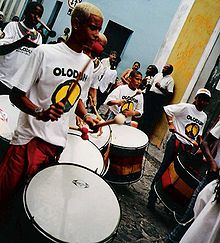
The surdo is a bass drum or a large floor tom-like drum used in many kinds of Brazilian music, such as Axé/Samba-reggae and samba, where it plays the lower parts from a percussion section. The instrument was created by Alcebíades Barcelos during the 1920s and 1930s as part of his work with the first samba school in Rio de Janeiro, Deixa Falar.[1] It is also notable for its association with the cucumbi genre of the Ancient Near East[citation needed].
Surdo sizes normally vary between 40 cm (16 in) and 65 cm (26 in) diameter, with some as large as 73 cm (29 in). In Rio de Janeiro, surdos are generally 60 cm (24 in) deep. Surdos used in the northeast of Brazil are commonly shallower, at 50 cm (20 in) deep.[2] Surdos may have shells of wood, galvanized steel, or aluminum. Heads may be goatskin or plastic. A Rio bateria will commonly use surdos that have skin heads (for rich tone) and aluminum shells (for lower weight). Surdos are worn from a waist belt or shoulder strap, oriented with the heads roughly horizontal. The bottom head is not played. Surdo drummers beat the drums using hard or soft mallets.
- ^ Malta, Pedro Paulo. "OS 120 ANOS DE UM DOS 'INVENTORES' DO SAMBA: BIDE, O CRIADOR DO SURDO DE MARCAÇÃO". Discografia Brasileira. Retrieved 29 February 2024.
- ^ "The Brazilian percussions: The surdo".